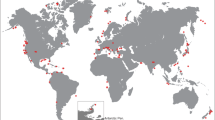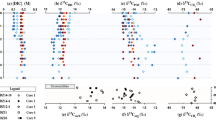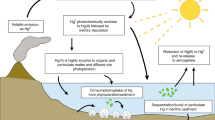Abstract
A pronounced negative carbon-isotope (δ13C) excursion of ∼5–7‰ (refs 1–7) indicates the occurrence of a significant perturbation to the global carbon cycle during the Early Jurassic period (early Toarcian age, ∼183 million years ago). The rapid release of 12C-enriched biogenic methane as a result of continental-shelf methane hydrate dissociation has been put forward as a possible explanation for this observation1,7,8. Here we report high-resolution organic carbon-isotope data from well-preserved mudrocks in Yorkshire, UK, which demonstrate that the carbon-isotope excursion occurred in three abrupt stages, each showing a shift of -2‰ to -3‰. Spectral analysis of these carbon-isotope measurements and of high-resolution carbonate abundance data reveals a regular cyclicity. We interpret these results as providing strong evidence that methane release proceeded in three rapid pulses and that these pulses were controlled by astronomically forced changes in climate, superimposed upon longer-term global warming. We also find that the first two pulses of methane release each coincided with the extinction of a large proportion of marine species9.
This is a preview of subscription content, access via your institution
Access options
Subscribe to this journal
Receive 51 print issues and online access
$199.00 per year
only $3.90 per issue
Buy this article
- Purchase on Springer Link
- Instant access to full article PDF
Prices may be subject to local taxes which are calculated during checkout


Similar content being viewed by others
References
Cohen, A. S., Coe, A. L., Harding, S. M. & Schwark, L. Osmium isotope evidence for the regulation of atmospheric CO2 by continental weathering. Geology 32, 157–160 (2004)
Küspert, W. G. in Cyclic and Event Stratification (eds Einsele, G. & Seilacher, A.) 482–501 (Springer, Berlin, 1982)
Schouten, S., Van Kaam-Peters, H. M. E., Rijpstra, W. I. C., Schoell, M. & Damste, J. S. Effects of an oceanic anoxic event on the stable carbon isotopic composition of Early Toarcian carbon. Am. J. Sci. 300, 1–22 (2000)
Sælen, G., Tyson, R. V., Telnæs, N. & Talbot, M. R. Contrasting watermass conditions during deposition of the Whitby Mudstone (Lower Jurassic) and the Kimmeridge Clay (Upper Jurassic) formations, UK. Palaeogeogr. Palaeoclimatol. Palaeoecol. 163, 163–196 (2000)
Röhl, H.-J., Schmid-Röhl, A., Oschmann, W., Frimmel, A. & Schwark, L. Erratum to “The Posidonia Shale (Lower Toarcian) of SW-Germany: an oxygen-depleted ecosystem controlled by sea level and palaeoclimate”. Palaeogeogr. Palaeoclimatol. Palaeoecol. 169, 273–299 (2001)
Jenkyns, H. C., Gröcke, D. R. & Hesselbo, S. P. Nitrogen isotope evidence for water mass denitrification during the early Toarcian (Jurassic) oceanic anoxic event. Palaeoceanography 16, 593–603 (2001)
Hesselbo, S. P. et al. Massive dissociation of gas hydrate during a Jurassic oceanic anoxic event. Nature 406, 392–395 (2000)
Beerling, D. J., Lomas, M. R. & Gröcke, D. R. On the nature of methane gas-hydrate dissociation during the Toarcian and Aptian oceanic anoxic events. Am. J. Sci. 302, 28–49 (2002)
Harries, P. J. & Little, C. T. S. The early Toarcian (Early Jurassic) and the Cenomanian-Turonian (Late Cretaceous) mass extinctions: similarities and contrasts. Palaeogeogr. Palaeoclimatol. Palaeoecol. 154, 39–66 (1999)
Jenkyns, H. C. The Early Toarcian (Jurassic) Anoxic Event - stratigraphic, sedimentary, and geochemical evidence. Am. J. Sci. 288, 101–151 (1988)
Jenkyns, H. C., Jones, C. E., Gröcke, D. R., Hesselbo, S. P. & Parkinson, D. N. Chemostratigraphy of the Jurassic System: applications, limitations and implications for palaeoceanography. J. Geol. Soc. Lond. 159, 351–378 (2002)
Bailey, T. R., Rosenthal, Y., McArthur, J. M., van de Schootbrugge, B. & Thirlwall, M. F. Paleoceanographic changes of the Late Pliensbachian-Early Toarcian interval: a possible link to the genesis of an Oceanic Anoxic Event. Earth Planet. Sci. Lett. 212, 307–320 (2003)
Jenkyns, H. C. Evidence for rapid climate change in the Mesozoic-Palaeogene greenhouse world. Phil. Trans. R. Soc. Lond. A 361, 1885–1916 (2003)
Benton, M. J. Diversification and extinction in the history of life. Science 268, 52–58 (1995)
Bucefalo Palliani, R., Mattioli, E. & Riding, J. B. The response of marine phytoplankton and sedimentary organic matter to the early Toarcian (Lower Jurassic) oceanic anoxic event in northern England. Mar. Micropaleontol. 46, 223–245 (2002)
Pálfy, J., Smith, P. L. & Mortensen, J. K. Dating the end-Triassic and Early Jurassic mass extinctions, correlative large igneous provinces, and isotopic events. Geol. Soc. Am. Spec. Pap. 356, 523–532 (2002)
Hinnov, L. A. & Park, J. J. Strategies for assessing Early-Middle (Pliensbachian-Aalenian) Jurassic cyclochronologies. Phil. Trans. R. Soc. Lond. A 357, 1831–1859 (1999)
Hallam, A. Estimates of the amount and rate of sea-level change across the Rhaetian-Hettangian and Pliensbachian-Toarcian boundaries (latest Triassic to early Jurassic). J. Geol. Soc. Lond. 154, 773–779 (1997)
Cope, J. C. W. Discussion on estimates of the amount and rate of sea-level change across the Rhaetian-Hettangian and Pliensbachian-Toarcian boundaries (latest Triassic to Early Jurassic). J. Geol. Soc. Lond. 155, 421–422 (1998)
Duncan, R. A., Hooper, P. R., Rehacek, J., Marsh, J. S. & Duncan, A. R. The timing and duration of the Karoo igneous event, southern Gondwana. J. Geophys. Res. 102, 18127–18138 (1997)
Dickens, G. R., O'Neil, J. R., Rea, D. K. & Owen, R. M. Dissociation of oceanic methane hydrate as a cause of the carbon isotope excursion at the end of the Paleocene. Paleoceanography 10, 965–971 (1995)
Paull, C. K., Buelow, W. J., Ussler, W. & Borowski, W. S. Increased continental-margin slumping frequency during sea-level lowstands above gas hydrate-bearing sediments. Geology 24, 143–146 (1996)
Bains, S., Corfield, R. M. & Norris, R. D. Mechanisms of climate warming at the end of the Paleocene. Science 285, 724–727 (1999)
Röhl, U., Bralower, T. J., Norris, R. D. & Wefer, G. New chronology for the late Paleocene thermal maximum and its environmental implications. Geology 28, 927–930 (2000)
Kurtz, A. C., Kump, L. R.,, Arthur, M. A.,, Zachos, J. C. & Paytan, A. Early Cenozoic decoupling of the global carbon and sulphur cycles. Paleoceanography 18, 1–14 (2003)
Svensen, H. et al. Release of methane from a volcanic basin as a mechanism for initial Eocene global warming. Nature 429, 542–545 (2004)
Kent, D. V. et al. A case for a comet impact trigger for the Paleocene/Eocene thermal maximum and carbon isotope excursion. Earth Planet. Sci. Lett. 211, 13–26 (2003)
Howarth, M. K. The ammonite family Hildoceratidae in the lower Jurassic of Britain. Palaeogr. Soc. Monogr. 145, 1–200 (1992)
Mann, M. E. & Lees, J. M. Robust estimation of background noise and signal detection in climatic time series. Clim. Change 33, 409–445 (1996)
Acknowledgements
D.B.K. was supported by a NERC CASE studentship with Bartington Instruments Ltd. We thank colleagues in the Department of Earth Sciences, The Open University, and the Geologisches Institut, Universität zu Köln, for analytical assistance and comments on an earlier draft of this manuscript. Author Contributions D.B.K, A.L.C. and A.S.C. collected samples and contributed equally to interpretation. L.S. was responsible for the carbon-isotope analyses.
Author information
Authors and Affiliations
Corresponding author
Ethics declarations
Competing interests
Reprints and permissions information is available at npg.nature.com/reprintsandpermissions. The authors declare no competing financial interests.
Supplementary information
Supplementary Figure S1
Carbon-isotope data across the early Toarcian compiled from various sources, which shows pronounced negative excursions in the δ13C of marine organic compounds, bulk marine organic matter, terrestrial wood material, and marine inorganic carbonate. (PDF 1136 kb)
Rights and permissions
About this article
Cite this article
Kemp, D., Coe, A., Cohen, A. et al. Astronomical pacing of methane release in the Early Jurassic period. Nature 437, 396–399 (2005). https://doi.org/10.1038/nature04037
Received:
Accepted:
Issue Date:
DOI: https://doi.org/10.1038/nature04037
This article is cited by
-
Early Jurassic extrinsic solar system dynamics versus intrinsic Earth processes: Toarcian sedimentation and benthic life in deep-sea contourite drift facies, Cardigan Bay Basin, UK
Progress in Earth and Planetary Science (2024)
-
The Toarcian Posidonia Shale at Salem (North Alpine Foreland Basin; South Germany): hydrocarbon potential and paleogeography
International Journal of Earth Sciences (2024)
-
Orbital pacing and secular evolution of lake-level changes reconstructed by sedimentary noise modeling during the Early Jurassic icehouses-(super)greenhouses
Science China Earth Sciences (2024)
-
Lower Jurassic (Pliensbachian–Toarcian) marine paleoenvironment in Western Europe: sedimentology, geochemistry and organic petrology of the wells Mainzholzen and Wickensen, Hils Syncline, Lower Saxony Basin
International Journal of Earth Sciences (2024)
-
Increase in the water level of Lake Baikal as a possible cause of changes in methane flux and concentrations in the water column
Environmental Earth Sciences (2023)
Comments
By submitting a comment you agree to abide by our Terms and Community Guidelines. If you find something abusive or that does not comply with our terms or guidelines please flag it as inappropriate.



